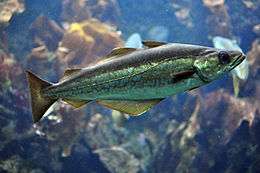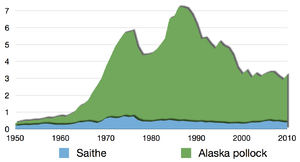Pollock
| Pollock | |
|---|---|
 | |
| Scientific classification | |
| Kingdom: | Animalia |
| Phylum: | Chordata |
| Class: | Actinopterygii |
| Order: | Gadiformes |
| Family: | Gadidae |
| Genus: | Pollachius Nilsson, 1832 |
Pollock (alternatively spelled pollack; pronounced /ˈpɒlək/) is the common name used for either of the two species of North Atlantic marine fish in the genus Pollachius ("P."). Both P. pollachius and P. virens are commonly referred to as pollock. Other names for P. pollachius include the Atlantic pollock, European pollock, lieu jaune, and lythe; while P. virens is sometimes known as Boston blues (distinct from bluefish), coalfish (or coley), silver bills or saithe.
Species
There are currently two recognized species in this genus:[1]
- Pollachius pollachius (Linnaeus, 1758) (Pollack)
- Pollachius virens (Linnaeus, 1758) (Saithe)
Description
Both species can grow to 3 ft 6 in (1.07 m) and can weigh up to 46 lb (21 kg). P. virens has a strongly defined, silvery lateral line running down the sides. Above the lateral line, the color is a greenish black. The belly is white, while P. pollachius has a distinctly crocked lateral line, grayish to golden belly and a dark brown back. P. pollachius also has a strong under-bite. It can be found in water up to 100 fathoms (600 ft; 180 m) deep over rocks, and anywhere in the water column. Pollock are a "whitefish".
Other fish called pollock
One member of the genus Gadus is also commonly referred to as pollock. This is the Alaska pollock or walleye pollock (Gadus chalcogrammus) including the form known as the Norwegian pollock. While related (they are also members of the family Gadidae) to the above pollock species, they are not members of the genus Pollachius. Alaska pollock generally spawn in late winter and early spring in the southeastern Bering Sea. The Alaska pollock is a significant part of the commercial fishery in the Gulf of Alaska.[2]
Parasites
Pollock and other species of gadids are plagued by parasites, one of which is the cod worm, Lernaeocera branchialis, a copepod crustacean. At its final stage, the female parasite, with fertilized eggs, clings to the gills of the fish and metamorphoses into a plump, sinusoidal, wormlike body, with a coiled mass of egg strings at the rear.
Fisheries


As food
| This article is one of a series on |
| Commercial fish |
|---|
| |
| Large pelagic |
| billfish, bonito mackerel, salmon shark, tuna |
|
|
| Forage |
| anchovy, herring menhaden, sardine shad, sprat |
|
|
| Demersal |
| cod, eel, flatfish pollock, ray |
| Mixed |
| carp, tilapia |
Atlantic pollock is largely considered to be a whitefish, although it is a fairly strongly flavored one. Traditionally a popular source of food in some countries, such as Norway, in the United Kingdom it has previously been largely consumed as a cheaper and versatile alternative to cod and haddock. However, in recent years pollock has become more popular due to over-fishing of cod and haddock. It can now be found in most supermarkets as fresh fillets or prepared freezer items. For example, it is used minced in fish fingers or as an ingredient in imitation crab meat.
Because of its slightly gray color, pollock is often prepared, as in Norway, as fried fish balls, or if juvenile sized, breaded with oatmeal and fried, as in Shetland. Year-old fish are traditionally split, salted and dried over a peat hearth in Orkney, where their texture becomes wooden. The fish can also be salted and smoked and achieve a salmon-like orange color (although it is not closely related to the salmon), as is the case in Germany where the fish is commonly sold as Seelachs or sea salmon. In Korea, pollock may be repeatedly frozen and defrosted to create hwangtae, half-dried to create ko-da-ri, or fully dried and eaten as book-o.
In 2009, U.K. supermarket Sainsbury's renamed pollock 'Colin' in a bid to boost ecofriendly sales of the fish as an alternative to cod.[4] Sainsbury's, which said the new name was derived from the French for cooked pollock (colin), launched the product under the banner "Colin and chips can save British cod."
In the U.S. and worldwide, Alaska pollock is the primary fish used by the McDonald's chain in their Filet-O-Fish sandwich.[5]
Notes
- ↑ Froese, Rainer, and Daniel Pauly, eds. (2012). Species of Pollachius in FishBase. April 2012 version.
- ↑ C.Michael Hogan. 2011. Gulf of Alaska. Topic ed. P. Saundry. Ed.-in-chief C.J.Cleveland. Encyclopedia of Earth. National council for Science and the Environment.
- 1 2 Based on data sourced from the relevant FAO Species Fact Sheets
- ↑ A colin and chips? Sainsbury's gives unfashionable pollack a makeover | Business | The Guardian
- ↑ Smith, K. Annabelle (March 1, 2013). "The Fishy History of the McDonald's Filet-O-Fish Sandwich". Smithsonian.com. Retrieved August 25, 2014.
References
- Froese, Rainer, and Daniel Pauly, eds. (2006). Species of Pollachius in FishBase. June 2006 version.
- Froese, Rainer and Pauly, Daniel, eds. (2006). "Pollachius pollachius" in FishBase. June 2006 version.
- Froese, Rainer and Pauly, Daniel, eds. (2006). "Pollachius virens" in FishBase. June 2006 version.
- Davidson, Alan. Oxford Companion to Food (1999), “Saithe”, p. 682. ISBN 0-19-211579-0
- Norum, Ben. Big Book of Ben, The (2007), "pollock / pollack", p. 32
External links
-
 "Pollack". Collier's New Encyclopedia. 1921.
"Pollack". Collier's New Encyclopedia. 1921. -
 "Coal-fish". Encyclopædia Britannica. 6 (11th ed.). 1911. p. 593.
"Coal-fish". Encyclopædia Britannica. 6 (11th ed.). 1911. p. 593.

.png)
